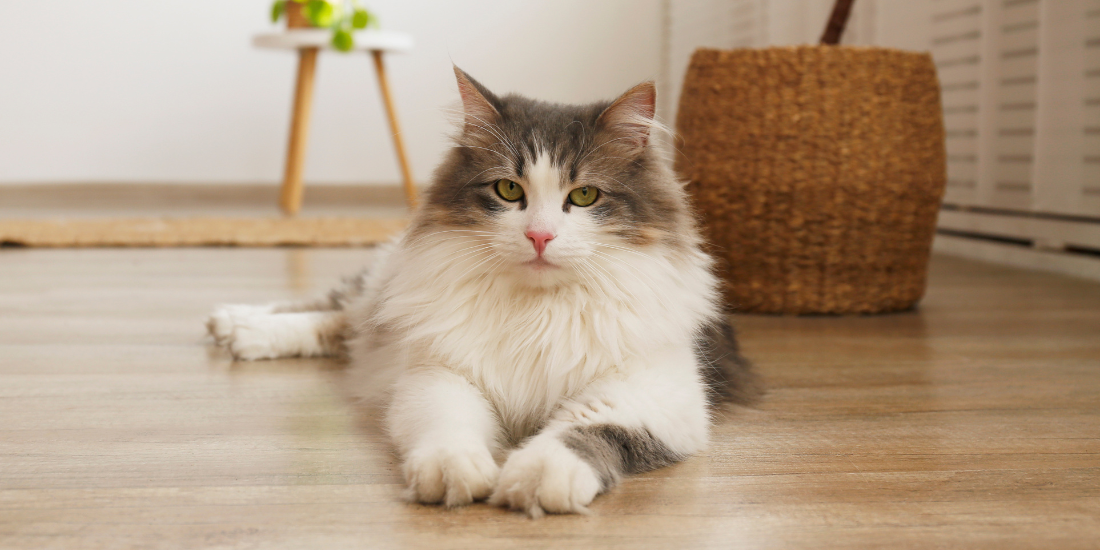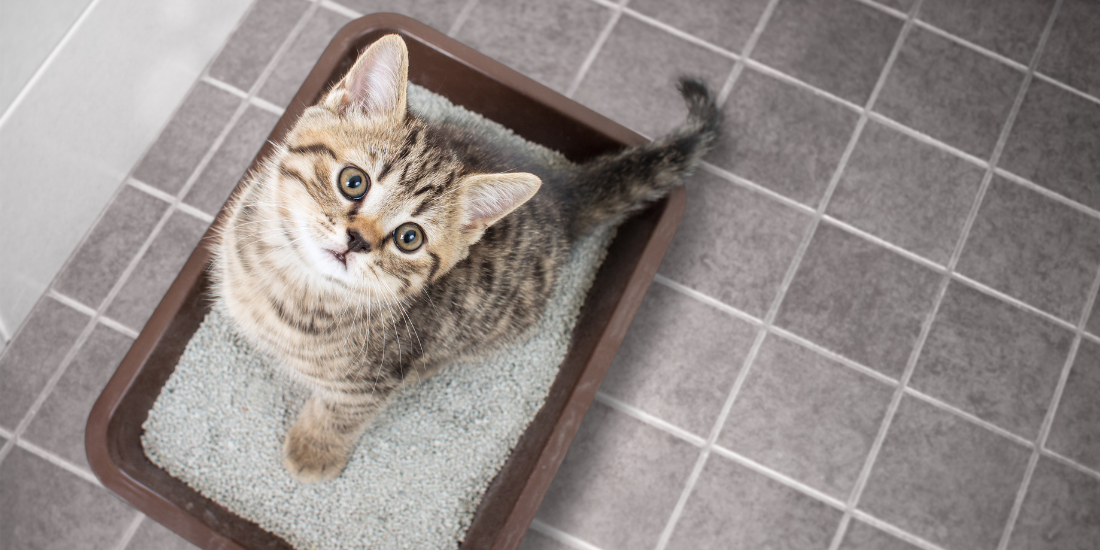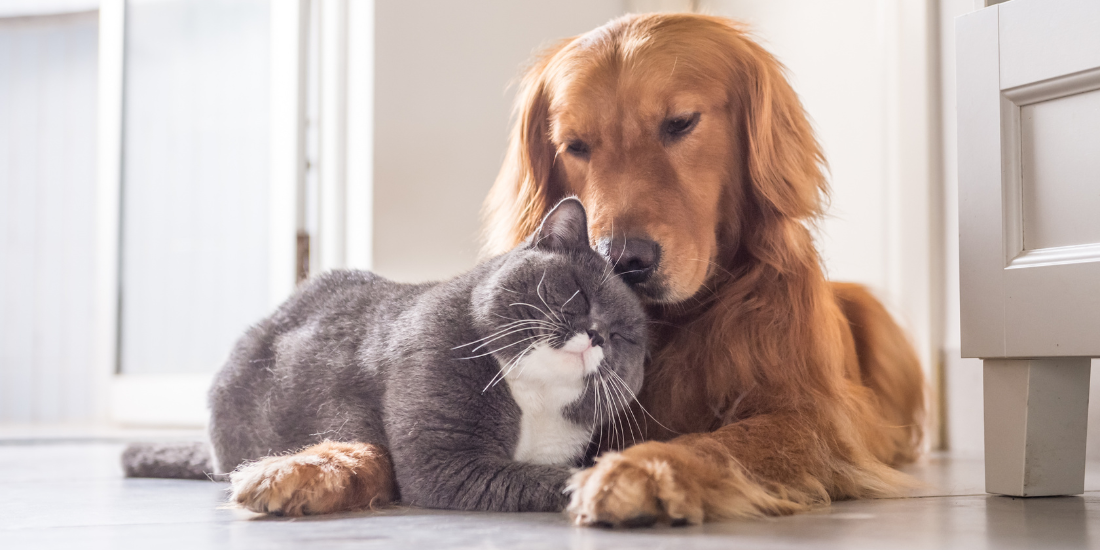
Cats often tell us more with their actions than their meows, and incessant scratching is no exception. This blog will take you on a whisker-twitching exploration of the various causes behind your cat's itchy escapades, from the pesky ringworm to the sneaky stress-triggered itches.
We're diving deep into the feline world to unravel the mysteries of itchy skin, because every purr, every scratch, has a story.
Ringworm
Ringworm, a common fungal infection particularly prevalent in kittens, young cats, or cats from shelters or extensive breeding environments, often leads to troublesome itchy skin.
How to spot ringworm in cats
This infection, not caused by worms but by dermatophytes — a group of fungi, is known for causing dry, crusty, itchy, and scabby lesions. These symptoms typically first appear on the ears and feet before potentially spreading to other areas of the body. The lesions can be itchy and as they progress lead to patches of hair loss.
The itchiness associated with ringworm arises from the body's immune response to the fungi, which thrive in warm, humid environments and can live on skin, surfaces, and household items. The discomfort and itching experienced with ringworm are due to the body's reaction to the presence of the fungus on the skin.
Ringworm treatments for cats
Given its contagious nature and potential to spread, it's crucial to seek veterinary treatment for your cat if you suspect ringworm, especially to prevent its spread throughout the household. While some cases can resolve quickly, others can take many months of treatment involving oral medications, topica creams and environmental management.
Stress
Stress plays a notable role in contributing to itchy skin in cats, and while it's rarely the sole cause of skin issues, it can significantly aggravate existing conditions.
Symptoms of stress in cats
Cats often express stress through over-grooming behaviours, which can lead to skin itchiness, redness, and other related issues. This over-grooming often targets easily accessible areas such as the inside of the legs and abdomen. Head and ear rubbing can lead to hair loss and inflamed areas on the face.
Additionally, mental imbalances like anxiety and fear, often triggered by changes in their environment — such as the introduction of new family members (both human and animal), relocating to a new house, the presence of new neighbours, shifts in weather, or even ongoing renovations — can manifest physically in the form of skin conditions.
Stress treatments for cats
Recognising and addressing the underlying stressors in your cat's life is essential for alleviating and preventing the exacerbation of these skin problems. Managing their stress not only improves their overall wellbeing but also aids in maintaining a healthy skin and coat.
Diet
One approach is the Royal Canin Calm Diet, which includes hydrolysed milk protein and L-tryptophan, ingredients known to help manage behavioural changes in cats exposed to unusual environments and situations. This special diet aids in calming and reducing stress-related behaviours.
Environmental modifications
In terms of environmental modifications, Feliway diffusers can be highly beneficial. The original Feliway diffuser is effective for stress induced by neighbouring cats, while the Feliway Friends version is designed to ease tensions among cats living in the same household.
Supplements
For direct supplementation, there is Zylkene 75mg Caps. It offers utilises a natural component derived from casein, a protein in milk known for its calming effect on newborns. Administering Zylkene is simple: the capsule can be mixed with food or given whole, catering to daily needs without preservatives or lactose.
Play
Speaking of play, engaging your cat in playful activities is another effective stress-reliever. Activities such as chasing laser lights, playing with iPad games, or interactive toys release endorphins that can help calm your cat.
In cases where dietary changes, environmental modifications, and supplements are not sufficient to manage stress, medication may be necessary. In such situations, it's important to consult with a veterinarian to explore appropriate calming medication options to ensure your cat's wellbeing and relief from stress-related skin issues.
Allergies
Allergies, arising from diverse sources such as food, fleas, or environmental factors, are a significant contributor to skin discomfort and intense itching in our feline companions.
How to spot if your cat has allergies
Signs that your cat might be suffering from an allergic reaction include the presence of scabs, ulcers, open sores, and severe itchiness.
As allergies can stem from an array of sources, determining the specific allergen often involves a process of elimination. Cats, much like dogs, can have multiple allergies, and reducing exposure to some allergens can significantly improve their condition, even when complete elimination is not feasible.
Commons allergy causes for cats
Among the most prevalent triggers for such allergic reactions are fleas, insect bites, feline parasitic diseases, diets and environmental allergens. Identifying and managing the allergens responsible is very beneficial in both preventing and alleviating these skin issues in cats.
Feline Parasitic Diseases
Including feline scabies (Notoedres cati), ear mites (Otodectes cynotis), and feline demodicosis (Demodex gatoi), typically present as pruritic facial dermatitis. These conditions are crucial to identify early, especially since cats with concurrent issues like food allergies may not show improvement with dietary changes alone if these parasites are present.
Flea
Flea allergies are another common cause of skin problems in cats. Those with lesions on the rump or tail and with miliary dermatitis are more susceptible to flea allergies. Effective flea control and managing the environment are essential steps in handling flea bite allergies, much like managing severe peanut allergies in children.
Insect bites
Particularly from mosquitoes, can also cause skin irritation, especially affecting sensitive areas like the ears and nose. Natural repellents, such as catnip, can be a deterrent to these insects. Planting citronella and reducing mosquito numbers along with active flea control can reduce the number of bites.
Immune disorders
Pemphigous foliaceous and plasma cell pododermatitis, which predominantly affect the paws, are also noteworthy contributors to skin allergies in cats. Certain breeds, including Sphynx cats, may have hereditary conditions that influence their susceptibility to these disorders. Recognizing these various causes is key to understanding the spectrum of skin allergies and related discomfort in cats. Cutaneous adverse food reactions (CAFR): often manifest as itching around the head and neck and are frequently accompanied by gastrointestinal symptoms. Cats with CAFR tend to exhibit more digestive issues compared to those with other types of hypersensitivity dermatitis.
Allergy treatments for cats
When it comes to treating allergies in cats, a multifaceted approach is often necessary due to the complexity and variety of potential allergens. This ensures both the relief of current symptoms and the prevention of future allergic episodes, enhancing the overall wellbeing of your feline friend.
Diet
Diet plays a crucial role, especially since cats can be more sensitive to dietary changes than dogs. Conducting a diet trial with specialized formulas such as Hills z/d, Royal Canin Hypoallergenic, or Proplan Ha can be beneficial. This involves feeding your cat exclusively with one of these diets for 6-8 weeks, followed by reintroducing small amounts of their previous food to determine if diet is a contributing factor to their allergies. If symptoms worsen upon reintroduction, it indicates food sensitivity. It's important to make any dietary changes gradually, sometimes over a month, to ensure the cat adjusts comfortably.
Allergen-Specific Immunotherapy (ASIT)
ASIT is another treatment option for chronic, non-flea, non-food induced allergies. Through serum allergy testing, more common than intradermal testing, specific allergens causing reactions can be identified. ASIT, administered either as subcutaneous injections or oral drops, requires several months to be effective and typically involves a dermatologist's input for dosage determination. Intradermal skin testing is currently much more accurate than serum testing.
Cyclosporine
Cyclosporine is prescribed for chronic allergic dermatitis management, taking about 2 to 3 weeks for maximum effect. It's not suitable for immediate relief but is also used for conditions like feline pemphigus foliaceus and other immune-mediated skin diseases. The minimum effective dose is recommended due to its potential side effects.
Corticosteroids
Prednisolone is often used to control itching in cats. It is very useful if used correctly at the lowest doses needed to control the disease. There are many side effects and these need to be evaluated on a risk/benefit analysis for your cat. If we can help reduce the doses needed with any other topical/diet/parasite control treatments and supplements we can minimise these effects.
Effective flea control
Checking for fleas can be done at home using a damp white paper towel during grooming - if flecks on the towel turn red, resembling blood, it indicates flea presence. Flea control products vary in effectiveness and duration, typically lasting 1-3 months. Regular treatment as directed and consulting with a veterinarian or veterinary nurse for safe options is crucial.
Sunburn
Sunburn in cats can lead to itchy skin, a result of skin damage and inflammation caused by overexposure to the sun.
Symptoms of sunburn in cats
Similar to humans, cats can suffer from redness, pain, and itching in sunburned areas, with a particular vulnerability in exposed regions like the ears, nose, and belly. This exposure can cause the skin to become scaly, thickened, or crusted, and in more severe cases, it may lead to skin ulcers and infection. Such complications increase discomfort and intensify the itching sensation.
Cats with lighter or sparser fur, as well as those with light-coloured skin, are more susceptible to sunburn. Preventing excessive sun exposure is crucial for these cats. If sunburn occurs, it's important to consult with a veterinarian.
How to stop your cat from getting sunburnt
Proactive measures and prompt treatment are key in managing and mitigating the discomfort associated with sunburn in cats.
Limit Sun Exposure
The most direct way to prevent sunburn is to keep your cat indoors during peak sunlight hours, usually between 10 a.m. and 4 p.m. This reduces their exposure to the strongest UV rays.
Use Sunscreen
Before your cat ventures outdoors, apply a pet-safe sunscreen on their ears, nose, and any other exposed skin areas. It's crucial to use sunscreen that is specifically formulated for cats and to reapply it as per the product instructions.
Provide Shaded Areas
For cats that spend time outdoors, ensure there are ample shaded spots available for them to retreat from the sun. This can include shaded patios, trees, or specially designed cat shelters.
UV-Blocking Film
For indoor cats that love sunbathing by the window, consider installing UV-blocking film on your windows. This film can significantly reduce the harmful rays entering your home while allowing your cat to enjoy their sunny spot safely.
How to treat sunburn in cats
Treatment for sunburn in cats include several steps can be taken to alleviate discomfort and facilitate healing
Cool Compress
Applying a cool compress to the sunburned areas for 5-15 minutes can help relieve the pain and reduce inflammation. This gentle approach can provide immediate relief for mild sunburn.
Pain Relief
Administering pain relief is a standard part of treating sunburn in cats. This helps to alleviate the discomfort associated with the sunburn and makes the cat more comfortable.
Cleansing Severe Lesions
In cases of severe sunburn, it may be necessary to cleanse or flush the affected areas. This helps to prevent infection and promotes the healing process. Topical Medications or Dressings: Your veterinarian may suggest applying topical medications or protective dressings to the sunburned areas.
These treatments aid in healing and can protect the affected skin from further damage.
Antibiotics: If the sunburn has led to an infection, antibiotics may be prescribed to combat the infection and prevent further complications.
Hospitalisation: In severe cases of sunburn, where the cat is in considerable pain or at risk of dehydration, hospitalisation might be required. This allows for more intensive treatment, such as intravenous fluids to rehydrate the cat and close monitoring of its condition.
Salmon Oil for Skin Health
Supplementing with essential fatty acids can play a vital role in enhancing and maintaining the health of your cat's skin. These supplements not only nourish the skin but also help in creating a protective barrier against external allergens, thereby promoting overall skin wellness in cats.
Why Salmon oil
Salmon oil high in Omega 3 fatty acids (EPA and DHA) is recommended however accurate doses can be challenging as there are minimal studies in cats. The current content of the diet ideally would also be considered. A guideline is 40mg/kg of EPA and 25mg/kg of DHA from marine based oils. There are good quality ethically sourced supplements like Antinol or Omega plus available that are palatable to most cats.
Incorporating salmon oil, which is rich in Omega 3 fatty acids, specifically EPA (Eicosapentaenoic Acid) and DHA (Docosahexaenoic Acid), is highly recommended for promoting skin health in cats. These fatty acids are known for their beneficial effects on skin condition and overall health. However, determining the correct dosage for cats can be a bit of a challenge, as there is a limited amount of research specifically focused on the optimal levels for feline health.
When considering the inclusion of salmon oil in your cat's diet, it's important to take into account the existing nutritional content of their regular food. The goal is to supplement their diet in a balanced way, without overloading them with certain nutrients. A general guideline for dosing is to aim for 40mg/kg of EPA and 25mg/kg of DHA from marine-based oils. This ratio ensures a balanced intake of these essential fatty acids, contributing positively to skin health and overall well-being.
For cat owners looking for high-quality options, there are several ethically sourced supplements available on the market, such as Antinol or Omega Plus. These products are specifically formulated to be palatable for cats, ensuring ease of administration. They provide a convenient and effective way to supplement your cat's diet with the essential fatty acids needed for maintaining healthy skin and a robust immune system. It's always recommended to consult with a veterinarian before introducing any new supplement to your cat's diet, to ensure it aligns with their specific health needs and dietary requirements.
Fish Oil
When considering fish oil supplements for your cat, it's important to be aware of the potential risks associated with certain ingredients. Fish oil may contain mercury or an excess of fat-soluble vitamins, particularly vitamin A or D. In cats, an excessive intake of vitamin D can lead to hypercalcemia, a condition characterized by an abnormally high level of calcium in the blood, and azotaemia, which involves elevated levels of nitrogen-containing compounds in the blood.
These conditions can have serious health implications for your cat.
Furthermore, while EPA (Eicosapentaenoic Acid) and DHA (Docosahexaenoic Acid) found in fish oil are beneficial, they can lead to adverse effects if provided in excessively high doses. It is crucial to use these supplements cautiously and adhere to recommended dosages to avoid such complications.
Cats undergoing fish oil supplementation should be monitored closely for any changes in their condition. This monitoring should extend over several weeks to months, carefully observing for any signs of improvement or deterioration in their primary health issues. Additionally, attention should be paid to potential adverse reactions. These could include gastrointestinal symptoms like vomiting and diarrhoea, the development of a fishy odour, or signs of decreased platelet activation, which can affect blood clotting.
In the feline world of itchy skin, it's all about sniffing out the root of the trouble, be it sneaky environmental culprits, dietary dilemmas, or pesky health hiccups like ringworm and sunburn. Each cat's itch is a unique story, and requires a specific treatment plan, from medical interventions for infections to behavioural modifications for stress-related issues.

About The Author
Dr Terryne Loney
Consultant Veterinarian | Pets: Roni, Barker and Corbett (Cats)
I have 30 years experience in companion animal practice and part of a nationwide veterinary senior leadership team. With a background of interest in all aspects of animal care, emotionally and physically, I am an advocate for wellness and fear free handling as well as dentistry, internal medicine, dermatology, oncology, and safe anaesthesia during surgery.
Enjoyed This?
Explore more ....


Litter Box Basics for Beginners: Tips Every Cat Owner Should Know

